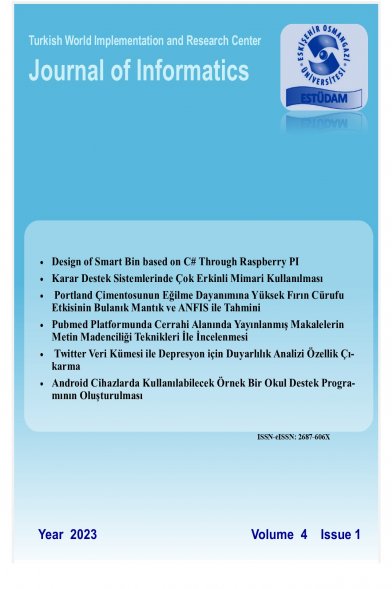Karar Destek Sistemlerinde Çok Erkinli Mimari Kullanılması
Özet: Karar destek sistemleri özellikle büyük verilere sahip bilgi sistemlerinde tüm veriyi işleyerek kullanıcılarının strateji geliştirmesinden, yatırım planlamasına kadar çok geniş bir yelpazede fikir veren sistemlerdir. Karar destek sistemleri bunu yaparken farklı algoritmalar seçilebilir. En çok kullanılan algoritma Analitik Hiyerarşi Prosestir. Bu çalışma çok yüksek veri yüküne sahip özellikle coğrafi bilgi sistemlerinde hesaplama işlemlerini birden fazla bilgisayara dağıtarak kullanıcıya daha hızlı raporlar verebilmeyi amaçlamaktadır. İletişim ve veri işlemede "Çok erkinli (ajanlı) sistemler" mimari ve metotları kullanılmıştır.
Anahtar Kelimeler:
dağıtık sistemler, karar destek sistemleri, çok erkinli sistemler, coğrafi Bilgi sistemi, distributed systems, decision support systems, multi agent systems, geographic information system
Using of Multi Agent System in Decision Support System
Abstract: Especially, decision support systems provide with large data to users by processing all the data in information systems from developing strategy, investment planning, and insight in a wide range. While doing this, different algorithms can be chosen. Most commonly used system is Analytic Hierarchy Process. This study is aimed faster reports that calculation of very high load of data in geographic information systems by distributing the processes across multiple machines. "Multi agent systems" architecture and methods are used in Communications and data processing.
Keywords:
dağıtık sistemler, karar destek sistemleri, çok erkinli sistemler, coğrafi Bilgi sistemi, distributed systems, decision support systems, multi agent systems, geographic information system,
___
- Ishizaka, A. and Labib, A., 1999. Analytic Hierarchy Process and Expert Choice, Benefits and Limitations, Portsmouth Business School, University of Portsmouth.
- Coğrafi bilgi sistem, http://tr.wikipedia.org/wiki/Co%C4%9Frafi_bilgi_sistemi, (Erişim Tarihi: 30.10.2021).
- Arslan V, Yılmaz G., 2010. Karar Destek Sistemlerinin Uygulanması İçin Uygun Bir Model Geliştirilmesi, Havacılık Ve Uzay Bilimleri Dergisi, Cilt 4 Sayı 4 (75-82).
- WSDL, http://www.w3.org/TR/wsdl, (Erişim Tarihi: 30.10.2021).
- SOAP, http://tr.wikipedia.org/wiki/SOAP, (Erişim Tarihi: 30.10.2021).
- Ubuntu, http://www.howtogeek.com/howto/ubuntu/installing-php5-and-apache-on-ubuntu/, (Erişim Tarihi: 30.10.2021).
- SOAPSERVER, http://www.php.net/manual/en/class.soapserver.php, (Erişim Tarihi: 30.10.2021).
- SOAPCLIENT, http://tr2.php.net/manual/en/class.soapclient.php, (Erişim Tarihi: 30.10.2021).
- Dong, C.S.J., Srinivasan, A., 2013. Agent-enabled Service Oriented Decision Support Systems, Decision Support Systems, 55, 364-373.
- Ozceylan, E., Erbas, M., Tolon, M., Kabak, M., Durgut, T., 2016. Evaluation of Fright Villages: A GIS-based Multi-criteria Decision Analysis, Computers in Industry, 76,. 38-52.
- Saarloos, D. J. M., Arentze, T. A., Borgers, A. W. J., Timmermans, H. J. P. 2008. A Multi-agent Paradigm as Structruing Principle for Planning Support Systems, Computers, Environment and Urban Systems, 32, 29-40.İnternet: Millî Eğitim Bakanlığı Hayat Boyu Öğrenme Kurumları Yönetmeliği, http://hbogm.meb.gov.tr/meb_iys_dosyalar/2018_04/11093946_MEB_HBO_KURUM LARI_YYNETMELYYY.pdf, 11 Nisan 2018.
- Laandgren, P., Srivastava, V. Leonard, N. E., 2021. Distributed Cooperative Decision Making in Multi-agent Multi-armed Bandits Automatica, Vol 125, https://doi.org/10.1016/j.automatica.2020.109445
- Radulescu, R., Mannion, P., Roijer, D. M., Nowe, A. (2020). Multi-objective Multi-agent Decision Making: a Utility-based Analysis and Survey. Autonomous Agents and Multi-Agent Systems (2020) 34:10 https://doi.org/10.1007/s10458-019-09433-x
- Bulling, N. (2014). A Survey of Multi-Agent Decision Making. Ku¤nstl Intell (2014) 28:147–158. DOI 10.1007/s13218-014-0314-3
- ISSN: 2687-606X
- Yayın Aralığı: Yılda 2 Sayı
- Başlangıç: 31.01.2020
- Yayıncı: Eskişehir Osmangazi Üniversitesi
Sayıdaki Diğer Makaleler
Android Cihazlarda Kullanılabilecek Örnek Bir Okul Destek Programının Oluşturulması
Eyyüp GÜLBANDILAR, Seher KIZILTEPE, Faik YAYLAK
Raspberry Pi ile C# tabanlı akıllı çöp kutusu tasarımı
Burak KOÇAK, Yusuf İslam ŞAHİN, Yılmaz KOÇAK
Twitter Veri Kümesi ile Depresyon için Duyarlılık Analizi Özellik Çıkarma
